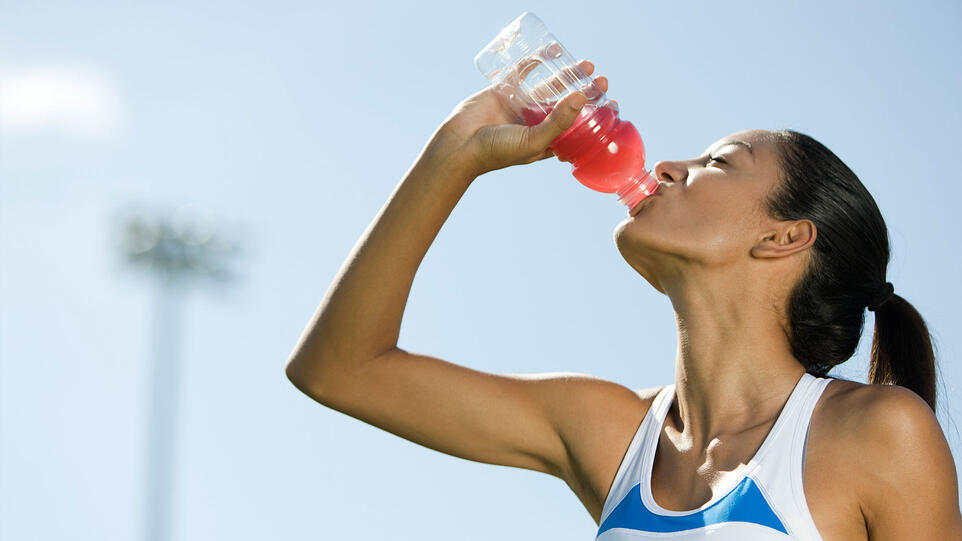
Colostrum
By Gene Bruno, MS, MHS – Dean of Academics, Huntington College of Health Sciences
Colostrum is the first milk that a mammal produces after pregnancy. This...
 Energy Sports Drinks
Energy Sports Drinks
By Gene Bruno, MS, MHS – Dean of Academics, Huntington College of Health Sciences
The longer an event lasts, the greater impact nutritional factors have on performance. In events lasting less than an hour, there is little need to consume extra fluid, electrolytes or calories during the physical activity. However, in longer events, problems such as glycogen depletion and hydration can occur.1
When liver and muscle stores of glycogen are depleted, any demanding physical activity comes to a halt. This is primarily due to a lack of readily available calories necessary to maintain blood sugar levels. As blood sugar levels drop, fatigue sets in. Low blood sugar is not immediately life threatening like dehydration but it does slow down performance.2 Carbohydrate loading in the days prior to the event will help store extra glycogen, but in long term events this must also be supplemented with some immediate form of calories 2-4 hours before exercise.3
Solid foods and high sugar solutions slow down gastric emptying and therefore should be avoided. Anything which contains fat or protein will cause more delay in gastric emptying than carbohydrates alone. Fruit juices contain too much sugar and are high in potassium and very low in sodium. Defizzed coke does not have any potassium or sodium and thus has no value in preventing hyponatremia (low sodium levels).4
Hyponatremia or salt depletion is not as common as dehydration, but can be a serious problem in long duration events. An athlete may lose over a liter of sweat per hour. This can lead to low levels of specific minerals inherent to sweat. Supplementing with these electrolytes may help maintain the body's electrolyte balance when vigorous or prolonged sweating occurs and mineral pools (i.e.: potassium) need to be replenished.5
Check out our product Designs for Health Electrolyte Synergy NOW!
Many individuals attempt to offset water, mineral and blood sugar depletion through the use of a commercial energy sports drink formulated for this purpose. Some energy sports drinks are premixed in a bottle, while others are in a powder form which can be easily mixed with water. Either way, in order for an energy sports drink can be effective it should have an osmolality of less than 300.5
The rate at which an energy sports drink is absorbed is dependent on osmolality and caloric concentration. Osmolality refers to the concentration of particles in a given amount of fluid. Normal body fluids have an osmolality of 275 to 298 mOsm/Kg. Solutions consumed with an osmolality greater than this are hyperosmolar and cause water to be drawn from the body into the stomach or gut in order to dilute and balance the osmolality. The resulting effect to the athlete is a delay in nutrient absorption and gastric emptying.5
According to Placido V.J. Macaraeg, Jr., M.D., an effective energy sports drink is one that extends endurance by replenishing calories, water and electrolytes in a balanced concentration that does not inhibit or slow down nutrient absorption. This requires an osmolality range of less than 300 mOsm/Kg. Macaraeg's research has shown that a low osmolality sports drink with a 5% carbohydrate (3% maltodextrin and 2% fructose) solution containing electrolytes such as potassium, sodium, calcium and magnesium significantly prolonged exercise duration in long-distance runners.6 An example of this would be if an energy sports drink contained about 21 grams or less of total carbohydrates (9 or less grams of which was fructose), and was mixed with 16 ounces of water.
Note: Although such a drink mix might be tastier if you mixed it with less water, you should still mix it with 16 ounces to achieve the correct osmolality.
What, you may wonder, is the advantage of using both maltodextrin and fructose? That is, why use both a complex and simple carbohydrate? The answer is very simple. The combination of these two energy fuels will help to keep the blood sugar more stable, and provide a more consistent source of energy than one fuel alone. As an analogy, think of building a fire: You start out with kindling wood to get the fire burning. This same principle holds true for sports energy drinks. The fructose provides an early energy fuel. The maltodextrin burns next for long-lasting energy.
Some energy sports drinks offer other advantages as well. For example, some provide antioxidants such as beta carotene and ascorbic acid (vitamin C), which can protect athletes against oxidative damage from high activity levels. Some even provide creatine monohydrate to help recycle ATP, thereby improving short-term energy.7 8
The most important thinks to look for in a sports energy drink are the blend of maltodextrin and fructose, and the electrolytes potassium, sodium, calcium and magnesium—as described above. In any case, endurance athletes are especially advised to consider the use of such a sports energy drink.
Smart Supplementation™ is a free series of educational literature created by Huntington College of Health Sciences (HCHS) as a public service. Although copyrighted, it may be freely photocopied and distributed, but may not be altered in any way. Smart Supplementation™ is not intended as medical advice. For diagnosis and treatment of any medical condition, consult your physician.
1. Davis, M.J., et al. 1988. Carbohydrate - electrolyte drinks: Effects on endurance cycling in the heat. Am. J. Clin Nutr. 48: 1023-30. 2. Hasson, S.M. & W.S. Barnes. 1987. Blood glucose levels during rest and exercise: influence of fructose and glucose ingestion. J. Sports Med. 27: 326-332. 3. Costil, D.L. 1988. Carbohydrates for exercise: Dietary demands for optimal performance - Technical Review. Int. J. Sports Med. 9: 1-8. 4. Kenney, J.J. (undated manuscript). Fluid, energy and electrolyte needs for ultra endurance cyclist. 5. American Dietetic Association. 1986. Fluid and Electrolytes. J. Amer. Dietetic Assoc. Continuing Education, Vol. 86, No. 8: 1010-1011. 6. Macaraeg, P.V.J. 1983. Influence of carbohydrate electrolyte ingestion on running endurance. In Nutrient Utilization During Exercise. Ross Symposium, Columbus, Ohio. 7. Whitney, E. and S. Rolfes, Understanding Nutrition. (1993), West Publishing, St. Paul, MN. pp. 449 8. Lehninger, A, Principles of biochemistry. (1982), Worth Publishers, New York. pp. 406.

Colostrum
By Gene Bruno, MS, MHS – Dean of Academics, Huntington College of Health Sciences
Colostrum is the first milk that a mammal produces after pregnancy. This...

By Gene Bruno, MS, MHS
Do not go gentle into that good night, Old age should burn and rave at close of day; Rage, rage...